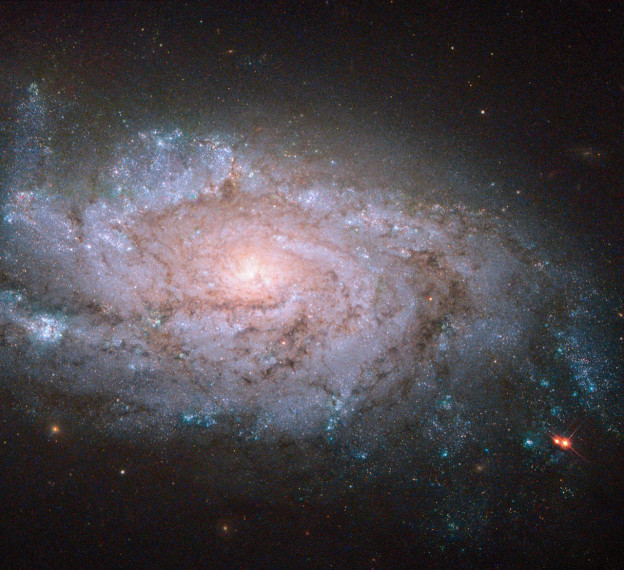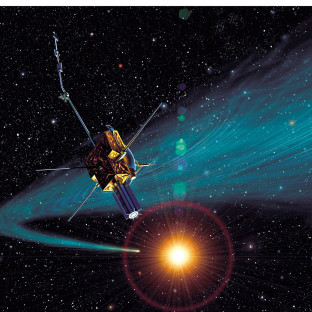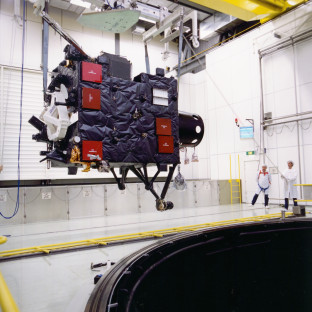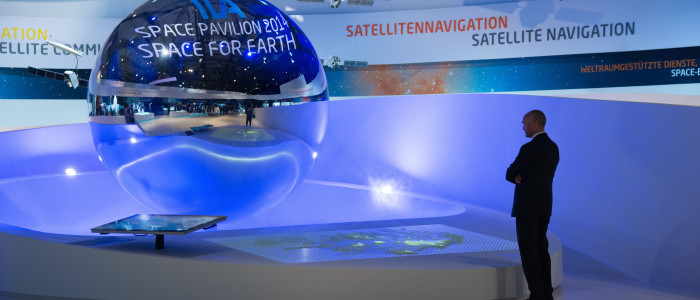
A spiral home to exploding stars. Credit: Hubble/ESA
Featured image: Space for Earth space pavilion at ILA. Credit: ESA.
Related articles: Cosmic Vision 2015 – 2025.
Establishing an intergovernmental space research organisation five decades ago was nearly a stroke of genius. Gathering the European countries in a common organisation ensured that Europe now is one of the main participants regarding space research, standing for several of the cutting edge technologies that bring space activities to one of the main platforms for basic and application research The collaboration means that Europe has developed important technologies, both bringing the research further, and even more importantly, using the knowledge and technologies for the good of society. The first years were more like an establishing phase and in 1989, after twenty-five years, the organisation had found its form. Most of the Western Europe nations were members and the different programmes ran as planned. Sweden and Denmark were two of the signature nations and have been members of ESA since the beginning. Norway entered the organization in 1986 and Finland followed in 1995.
Halfway Since the Establishment – What the Future Holds
The Budgets
In 1989, the budgets were calculated in Accounting Units, a theoretical money unit before the Euro was introduced. Today the unit is Euro and the size of the budgets is rather difficult to compare, but the distribution in percent is still relevant. In 1989, like today, France, Germany and Italy were the largest contributors with smaller shares from the other member states. The biggest difference today is the number of member states, a number that has increased from 13 to 20. Today’s total budget is 4100 million Euros, a small decrease from 2013, mainly due to the economic situation in some of the member states. (To comparison, NASA’s 2013 budget was 17,8 bill. US Dollar, or about 13 000 M Euros.) The distribution between the sectors in 2014 is compared with the distribution twenty-five years ago: ESA budgets in percents related to the year 1989 and 2014 Science: from 9.8 to 12.3 %, Earth Observation: 9.0 to 22.3 %, Telecommunication and applications: 9.8 – 7.9 %, Space Station and platforms/human spaceflight: 17.1 – 9.0, Space transportation: 38.7 – 15.1 %, Navigation: 0.0 – 15,9 % and other, general, technology etc. from 15.0 to 17.5%.
The Distribution Varies Widely. Why?
European earth observation activities in 1986, were in the early start with preparation for the first European Remote Sensing satellite ERS-1. The following years the earth observation activities continuously played an increasing part of ESA’s activities. The high share today is to a large degree related to the development of the Sentinel satellites and the next generations of weather satellites. Space station and human spaceflight had a large share in 1989. The International Space Station ISS was at this time known as the American space station “Freedom”, a project where Europe played its . The high share had connection with the development of the Columbus laboratory. Today the human spaceflight and microgravity activities have a more routine mark activity, and not the same share. Space transportation had a very large share of the budget in 1989. The European principle ” Independent Access to Space” was determined to access its own large launcher and the development of Ariane 5 was in very busy development phase, the maiden flight came in 1996. Today this field has a lower activity level, but it is likely that the activities will increase again with the development of the next generation of launchers. Navigation was introduced as new research area during the last twenty-five years. I 1989 the American Global Positioning System (GPS) and the Russian Glonass were the only navigation systems based on satellites. Unfortunately, both systems were controlled by the military and could be switched off without an alternative. The understanding of this situation led to the development of a civilian European system, originally planned operative in 2008, but only now one can see the end of the programme, and the large share of the budget in recent years can decrease the next years. Science is one of the cornerstones of the ESA activities and today has a share of 12,3 %, a slight increase in recent decades. However, ESA in only responsible for developing, building, launching and managing the satellites, the scientific instruments on board are developed and paid for by the scientific institutes, or countries, as participates in the project. The money Europe spends on space research is therefore much larger.
The Science Programmes in 1986

Artist_s_impression_of_the_Ulysses_spacecraft. Credit. ESA.
The scientific programmes are possibly the programmes whose main technology is always in the cutting edge of the developing. 1989 was a busy year for ESA with several large programmes in the developing and building phase, programmes that today are well known and for the most part- successful. Ulysses had been in storage for several years, but was now in the final preparation for launch late1990. From the annual report one can read. “Liaison between the various NASA centres, the scientific community, industry and ESA continued to be good despite the many years of delay and frustration”. Ulysses was, as we now know, a big success – at last. Hubble Space Telescope was in the final phase for the launch date in 1990. ESA delivered the Faint Object Camera and the solar array for the project. Due to the delay of launch from 1989 to 1990 the solar array was returned to ESA for an upgrade the year before. In spite of some difficulties the first years, the later service missions ensured that Hubble Space Telescope became an important source of knowledge. Hipparcos was launched late that year. The satellite, a star mapper, detected and catalogued stars with high precision. Also this mission was successful, and twenty- five years later, the successor Gaia was launched late in 2013. ISO, or Infrared Space Observatory was also in the final phase of building for a launch date in 1993. The launch was successful and the satellite delivered valuable data for the community in the nineties until the satellite ran out of cooling medium. SOHO or Solar and Heliosperic Observatory was also in the developing phase for a launch of 1995. Also this mission fulfilled the expectations, and still, some of the instruments deliver data to the community nearly twenty years after the launch.

Rosetta – here during tests before launch in 2004, now very near the target, Comet 67P/Churyumov-Gersimenko
Of other missions that were planned , or in the developing phase should be mentioned. Cluster, the four-satellite constellation was destroyed in the first launch attempt, but Cluster 2 was launched in 2002 and still delivers scientific data. X-ray Multi Mirror Mission (XMM) was in the early developing phase for a launch in 2001/2002 timeframe. The satellite was launched, but is now out of service. Rosetta was also in the early developing phase, and interestingly, after ten years in space, the satellite will reach its target in ESA’ jubilee year. Two other missions on the desk that year was the Huygens probe and the Far Infrared Submillimetre Telescope (FIRST). The Huygens probe landed at Titan as planned in 2004 and FIRST, later named Planck, completed its mission in October 2013.
The Long -Term Programmes.
To give the scientific community predictability ESA introduced the first long- term programme in 1985 and named it Horizon 2000. The programme ran until1994 and was relieved by Horizon 2000+. The long- time programmes drew the main lines for the scientific activities, and gave the scientific community possibilities for long- time planning. Running until 2005, the first two programmes were replaced by the running programme Cosmic Vision 2015 – 2025.
Related article: Cosmic Vision 2015 – 2025


